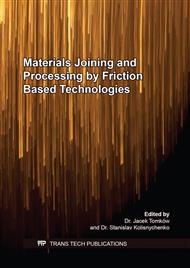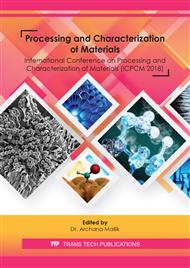[1]
B. T. Gibson, D. H. Lammlein, T. J. Prater, W. R. Longhurst, C. D. Cox, M. C. Ballun, K. J. Dharmaraj, G. E. Cook, and A. M. Strauss, Friction stir welding: process, automation, and control, J Manuf Process. (2014); 16(1):56-73.
DOI: 10.1016/j.jmapro.2013.04.002
Google Scholar
[2]
S. Rajakumar, C. Muralidharan, and V. Balasubramanian, Establishing empirical relationships to predict grain size and tensile strength of friction stir welded AA 6061-T6 aluminium alloy joints, Trans Nonferrous Met Soc of China. (2010); 20(10):1863-72.
DOI: 10.1016/s1003-6326(09)60387-3
Google Scholar
[3]
M. H. Shojaeefard, A. Khalkhali, M. Akbari, and P. Asadi, Investigation of friction stir welding tool parameters using FEM and neural network, Proceedings of the Institution of Tensile Engineers, Part L: J Mater: Des Applica. (2015); 229(3):209-17.
DOI: 10.1177/1464420713509075
Google Scholar
[4]
W. M. Thomas, K. I. Johnson, and C. S. Wiesner, Friction stir welding–recent developments in tool and process technologies, Advanc Eng Mater. (2003); 5(7):485-90.
DOI: 10.1002/adem.200300355
Google Scholar
[5]
R. S, Mishra, and Z. Y. Ma, Friction stir welding and processing." Mater Sci Eng : R: Reports. (2005);50(1):1-78.
Google Scholar
[6]
He Xiaocong, F. Gu, and A. Ball, A review of numerical analysis of friction stir welding, Progress in Mater Sci. (2014);65:1-66.
DOI: 10.1016/j.pmatsci.2014.03.003
Google Scholar
[7]
Y.H. Zhao, S. B. Lin, F. X. Qu, and L. Wu, Influence of pin geometry on material flow in friction stir welding process, Mater letters. (2005); 59(23):2948-52.
DOI: 10.1016/j.matlet.2005.04.048
Google Scholar
[8]
O. Lorrain, , V. Favier, H. Zahrouni, and D. Lawrjaniec, Understanding the material flow path of friction stir welding process using unthreaded tools, J Mater Process Technol. (2010); 210(4):603-9.
DOI: 10.1016/j.jmatprotec.2009.11.005
Google Scholar
[9]
A. F. Hasan, C. J. Bennett, and P. H. Shipway, A numerical comparison of the flow behaviour in Friction Stir Welding (FSW) using unworn and worn tool geometries, Mater Des. (2015); 87:1037-46.
DOI: 10.1016/j.matdes.2015.08.016
Google Scholar
[10]
J. Marzbanrad, , M. Akbari, P. Asadi, and S. Safaee, Characterization of the influence of tool pin profile on microstructural and mechanical properties of friction stir welding, Metall Mater Trans B. (2014);45(5):1887-94.
DOI: 10.1007/s11663-014-0089-9
Google Scholar
[11]
C. N. Suresha, B. M. Rajaprakash, and S. Upadhya, A study of the effect of tool pin profiles on tensile strength of welded joints produced using friction stir welding process, Mater Manuf Process. (2011); 26(9):1111-6.
DOI: 10.1080/10426914.2010.532527
Google Scholar
[12]
H. J. Liu, H. Fujii, M. Maeda, and K. Nogi, Tensile properties and fracture locations of friction-stir-welded joints of 2017-T351 aluminum alloy, J Mater Process Technol. (2003); 142(3):692-6.
DOI: 10.1016/s0924-0136(03)00806-9
Google Scholar
[13]
S. Muthukumaran, and S. K. Mukherjee, Multi-layered metal flow and formation of onion rings in friction stir welds, Int J Advanc Manuf Technol. (2008); 38(1):68-73.
DOI: 10.1007/s00170-007-1071-3
Google Scholar
[14]
K. S. Kumar, V. K., and S. V. Kailas, The role of friction stir welding tool on material flow and weld formation, Mater Sci Eng : A. (2008); 485(1):367-74.
DOI: 10.1016/j.msea.2007.08.013
Google Scholar
[15]
O. Lorrain, V. Favier, H. Zahrouni, and D. Lawrjaniec, Friction stir welding using unthreaded tools: analysis of the flow, Int J Mater For . (2010); 3:1043-6.
DOI: 10.1007/s12289-010-0949-z
Google Scholar
[16]
O. Lorrain, , J. Serri, V. Favier, H. Zahrouni, and M. El Hadrouz, A contribution to a critical review of friction stir welding numerical simulation, J mech mater struct. (2009); 4(2):351-69.
DOI: 10.2140/jomms.2009.4.351
Google Scholar
[17]
A, Dorbane, G. Ayoub, B. Mansoor, R. F. Hamade, and A. Imad, Effect of Temperature on Microstructure and Fracture Mechanisms in Friction Stir Welded Al6061 Joints, J Mater Eng Perf. (2017); 26(6):2542-54.
DOI: 10.1007/s11665-017-2704-9
Google Scholar
[18]
E. Salari, M. Jahazi, A. Khodabandeh, and H. Ghasemi-Nanesa, Influence of tool geometry and rotational speed on mechanical properties and defect formation in friction stir lap welded 5456 aluminum alloy sheets, Mater Des. (2014); 58:381-9.
DOI: 10.1016/j.matdes.2014.02.005
Google Scholar
[19]
P. Prakash, S. K. Jha, and S. P. Lal, Effect of Tool-Pin Profile on Weld Zone and Mechanical Properties in Friction Stir Welding of Aluminium Alloy, Pertanika J of Sci.& Tech. (2018). 26, no. 2.
Google Scholar



